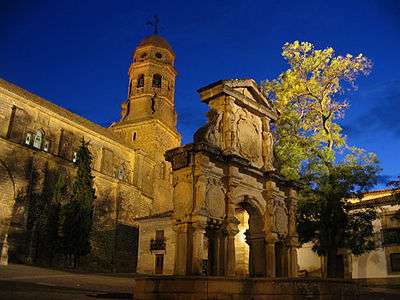Roman Catholic Diocese of Baeza
The Roman Catholic Diocese of Baeza (Latin Beatia) was a Visigothic Catholic bishopric, suppressed under Moorish rule and shortly restored in the 13th century, which remains a Latin titular see.

Santa María fountain and cathedral of Baeza
History
- Some claim that Ancient Roman Beatia became the seat of a bishop in the Visigothic Kingdom of Toledo between 656 and 675, when the Diocese of Castulo was transferred to Beatia, on territory previously belonging to the Diocese of Tucci.
- In 715 was established a Diocese of Baeza / Beatia (Curiate Italian = Latin) / Biatien(sis) (Latin adjective) in its own right, on canonical territory split off from the suppressed Diocese of Tucci, as a suffragan of the Archbishopric of Toledo (in the Visigothic and later Castilian royal capital), but the Moorish rule (since 711) doomed it after a few more bishops, including martyrs.
- In 900 the bishopric was suppressed, but king Alfonso VIII of Castile (1158-1214) still mentions it in his Chronicle
- The diocese was shortly restored from 1127, when the Baeza Cathedral, dedicated to the Assumption of Mary (which the Moors had turned into a mosque), was reinstated (Catedral de la Asunción de la Virgen), until 1249, when the see was transferred for good and its territory merged into the Roman Catholic Diocese of Jaén. The former cathedral, although a Minor World heritage site (since 2003 part of a UNESCO World Heritage Site with other monuments in Baeza and in the nearby city of Úbeda), never became a (co-)cathedral again.
Residential Ordinaries

Baeza's former cathedral of the Assumption
(all Latin Rite; incomplete)
Recorded Suffragan Bishops of Baeza were :
Titular see
No longer a residential bishopric, Beatia is today listed by the Catholic Church as a Latin titular see.[1]
It has had the following incumbents, so far of the fitting Episcopal (lowest) rank :
- Albin Małysiak, Lazarists (C.M.) (1970.01.14 – death 2011.07.16), as Auxiliary Bishop of Archdiocese of Krakow (Poland) (1970.01.14 – retired 1993.02.27) and on emeritate
- Wiesław Śmigiel (2012.03.24 – ...), Auxiliary Bishop of Diocese of Pelplin (Poland) (2012.03.24 – ...).
See also
References
Sources and external links
This article is issued from
Wikipedia.
The text is licensed under Creative Commons - Attribution - Sharealike.
Additional terms may apply for the media files.